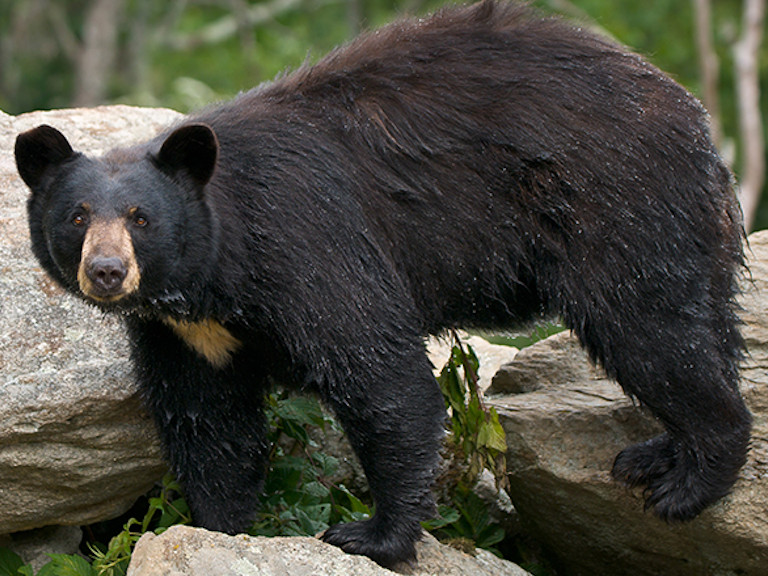Essential Tips for Staying Bear Safe in the Smokies
Whenever my in-laws visit the Smokies, their top priority is to see bears. They’ve spotted many in the years they’ve been visiting the Great Smoky Mountains; in fact, they’ve seen as many as 13 in one trip to Cades Cove! Catching a glimpse of a bear up close is exciting and a truly unique experience – it’s not something you do every day. But seeing bears in their natural habitat also comes with its dangers.
Because of the park’s inviting setting and plethora of tourists, visitors sometimes forget that bears are wild animals. Spotting a bear (and maybe her cubs!) in the Great Smoky Mountains National Park is not like seeing a bear at the zoo. You are in the bear’s home, so you need to play by the rules of nature. The same can be said about your actions around your cabin.
Our Pigeon Forge cabins are set amongst the beautiful, natural surroundings of the Smokies, so once again, you’re in the bears’ habitat. Many of our guests have had some exciting bear sightings near their cabins. To make sure you have a safe, fun, and memorable Smoky Mountain vacation, follow best practices for bear safety.
Read on for top tips from the National Park Service for staying safe around bears, whether hiking, picnicking, hanging around the cabin, or taking a scenic drive. We also answer some frequently asked questions about bears in the Smokies and in and around Pigeon Forge. And remember, the best way to prevent a bear attack is by avoiding an encounter in the first place. For more information about bear safety, visit the National Park Service website.
Keep your distance.
Use binoculars to get a closer view of bears instead of approaching them. Always follow the park’s signs for safe viewing distances, and listen to park rangers anytime they give you instructions. This will keep you safe, but it will also allow you to enjoy seeing the bears act naturally in their home!
Always hike, picnic, and explore in groups. Safety in numbers is for more than just avoiding getting lost while hiking. It’s also a good rule of thumb when you’re anywhere around bears.
Keep the noise down.
If you do have the fun experience of spotting a bear, try not to be too loud. You don’t want to startle the bear or make it feel threatened. Follow this with one notable exception; in areas of low visibility or along the trail, speak calmly but firmly to identify yourself as a human and not surprise the bear.
Follow the rules.
Listen to park rangers’ instructions, obey safety signs, and always stay on designated trails. Pets are not allowed on most trails in the area, and this is another bear safety issue. Let’s keep those pups – and YOU – safe!
Leave baby bears alone.
When you see a baby bear by itself, it probably has a mother nearby. Even if you think the bear is injured or sick, DO NOT approach the bear. If you think there is trouble, contact a park ranger.
Don’t feed the bears.
Feeding bears is not only dangerous to you, but it’s also dangerous for the bears. If bears get used to being fed at picnic areas (on purpose or via improper food storage), they may become aggressive and attack in those areas. If a bear attacks, it will have to be put down, so everyone loses in that scenario. This is a good tip for time around the cabin as well.
Put away your trash.
Don’t inadvertently feed bears. Put any trash in closed bins with bear cages or keep it inside the cabin. Don’t leave food or drinks outside or sitting around in the car.
FAQs
What kind of bears are in the Great Smoky Mountains National Park?
The Great Smoky Mountains National Park in Tennessee and North Carolina is home to black bears. Attacks are rare, but if you are attacked by a black bear, DO NOT PLAY DEAD. If you can escape, get to a car or building. If you can’t, fight back with any nearby objects, keeping most of your hits and kicks to the bear’s face and muzzle.
What do I do if I encounter a bear?
The National Park Service recommends the following if you do come across a bear that also notices you:
- Identify yourself.
- Stay calm.
- Pick up small children.
- Make yourself look as large as possible (move to higher ground).
- Do NOT allow the bear to access your food.
- Do NOT drop your pack (keep it for protection).
- Move away slowly and sideways (if the bear is not moving).
- Leave the area.
- Be cautious around females with cubs.
Are there any tools to protect myself from bears?
Bear-deterrent spray is good to have on hand if you’ll be spending time in the backcountry. It is only to be used if you encounter an aggressive, charging, or attacking bear. It is not, however, recommended for areas with a lot of people, such as picnic areas and busy trails. Be sure to check with officials at the Great Smoky Mountains National Park beforehand to see if the bear-deterrent spray is appropriate.


